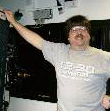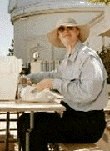|
|
This topic comprises 3 pages: 1 2 3
|
|
Author
|
Topic: Making Up Prints
|
|
|
Scott Norwood
Film God

Posts: 8146
From: Boston, MA. USA (1774.21 miles northeast of Dallas)
Registered: Jun 99
|
 posted 04-01-2001 06:08 PM
posted 04-01-2001 06:08 PM





I'd say that, on average, it takes me (personally) about 30-60 minutes to inspect a print in "typical" second-run condition. I don't think it makes much difference when dealing with small reels, large reels, or platters. With small reels, one must inspect the cue marks on each reel; with large reels, only one set of cues usually requires inspection, but the same amount of time is required to remove appropriate leaders and tails and splice everything together. With platters, there's no need to inspect for cue marks at all, but, if automation is involved, there are usually several cues that need to be added to a print, which also takes time. Obviously, there is no "break-down" time required for small reels, however, which makes them more appropriate for theatres where films change frequently (not to mention that they make it possible to inspect part of the feature while the first reel is running).
Obviously, this process takes some people more time than others, and some prints require more repair work than others, and I suspect that something like a Goldberg platter reel (see the reviews section) would save quite a bit of time as well.
The other variable is the particular theatre's trailer arrangement. I'm not counting this here, since trailer work can usually be done ahead of time before the print arrives. Splicing together one or two trailers can be done in a couple of minutes, but a full-blown trailer reel with commercials, snipes for coming attractions, feature presentation, sound format, etc., as well as 4-5 trailers will take significantly longer.
| IP: Logged
|
|
|
|
|
|
|
|
Aaron Mehocic
Jedi Master Film Handler
Posts: 804
From: New Castle, PA, USA
Registered: Jun 99
|
 posted 04-02-2001 03:07 PM
posted 04-02-2001 03:07 PM




Do you guys do the job on Thursday nights or early Friday mornings?(We know already know about Darryl)
| IP: Logged
|
|
|
|
|
|
John Pytlak
Film God

Posts: 9987
From: Rochester, NY 14650-1922
Registered: Jan 2000
|
 posted 04-04-2001 01:16 PM
posted 04-04-2001 01:16 PM





My experience is along the line of Jeffry's -- a full inspection should take about as long as the running time of the print. If you are doing it much faster, you are either winding through the film too fast, or not really taking the time to find film damage or bad splices that could interrupt the show.IMHO, putting an uninspected shipping reel on the makeup table (MUT), making the splice, and walking away as the film winds onto the platter, is NOT good practice. Just because the reel arrives heads out, or is a new print, or has an "Integrity Inspected" sticker, doesn't mean it is ready to project!  One of my mentors once told me: "Never ASSUME anything -- it will make an ASS out of yoU and ME".  YOU are reponsible for what goes up on the screen and though the speakers. YOU are responsible for "Doing Film Right". (And of course, YOU do!) 
------------------
John P. Pytlak, Senior Technical Specialist
Worldwide Technical Services, Entertainment Imaging
Eastman Kodak Company
Research Labs, Building 69, Room 7419
Rochester, New York, 14650-1922 USA
Tel: 716-477-5325 Cell: 716-781-4036 Fax: 716-722-7243
E-Mail: john.pytlak@kodak.com
Web site: http://www.kodak.com/go/motion
| IP: Logged
|
|
|
|
John Pytlak
Film God

Posts: 9987
From: Rochester, NY 14650-1922
Registered: Jan 2000
|
 posted 04-05-2001 03:29 PM
posted 04-05-2001 03:29 PM





Actually screening a film prior to the opening is always a good idea, IF you have the time. But careful inspection during make-up will find most of the problems that are within your power to correct. Taking the time to do a thorough "edges between the fingers" inspection will find 99% of any problems.Your point about having the proper light for inspection is a good one. A good illuminator is invaluable for looking at the image as you inspect and splice the film. There are now portable battery-powered fluorescent illuminators and lamps that can easily be brought to the MUT or rewind bench. For finding scratches, nothing beats a bright specular light. A small spotlight, or even a high intensity quarz halogen desk lamp work well. Holding the film in the beam of a projector also makes any scratches or surface defects very easy to see.
Grainger Lighting Products Use an obsolete lens as a high quality magnifier. I have an old Kodak EKTAR 28mm Super-8 projection lens that is better than any jewelers loupe for magnifying tiny objects. Radio Shack and Edmund Scientific also sell "pocket microscopes" that are great for looking at sprocket teeth for wear.
Radio Shack 30X Microscope ------------------
John P. Pytlak, Senior Technical Specialist
Worldwide Technical Services, Entertainment Imaging
Eastman Kodak Company
Research Labs, Building 69, Room 7419
Rochester, New York, 14650-1922 USA
Tel: 716-477-5325 Cell: 716-781-4036 Fax: 716-722-7243
E-Mail: john.pytlak@kodak.com
Web site: http://www.kodak.com/go/motion
| IP: Logged
|
|
Christopher Seo
Jedi Master Film Handler

Posts: 530
From: Los Angeles, CA
Registered: Jun 99
|
 posted 04-06-2001 04:38 AM
posted 04-06-2001 04:38 AM




Yes, after some practice lab splices will be discernable from random edge scuffing while feeling the film by hand (gloved or not) during inspection. This is much quicker than and preferable to backing a film off the platter to find a lab splice (yes, I had to do that once).Actually, I prefer to get a print all tails out. Since I inspect to 6000s this saves a rewind before going onto the platter. Even in a rush, building to 6000s first is no problem, because while one 6k loads to platter you can be making up the next 6k. Also you have all the advantages of working at a rewind bench, which is good lighting, not having to bend over, and being able to stop, start, and change speed easily which a bulky platter isn't designed to do.
| IP: Logged
|
|
|
|
|
|
|
|
|
|
All times are Central (GMT -6:00)
|
This topic comprises 3 pages: 1 2 3
|
Powered by Infopop Corporation
UBB.classicTM
6.3.1.2
The Film-Tech Forums are designed for various members related to the cinema industry to express their opinions, viewpoints and testimonials on various products, services and events based upon speculation, personal knowledge and factual information through use, therefore all views represented here allow no liability upon the publishers of this web site and the owners of said views assume no liability for any ill will resulting from these postings. The posts made here are for educational as well as entertainment purposes and as such anyone viewing this portion of the website must accept these views as statements of the author of that opinion
and agrees to release the authors from any and all liability.
|

 Home
Home
 Products
Products
 Store
Store
 Forum
Forum
 Warehouse
Warehouse
 Contact Us
Contact Us




 Printer-friendly view of this topic
Printer-friendly view of this topic






















